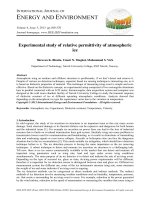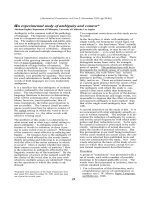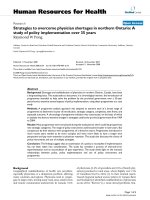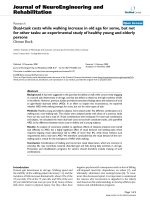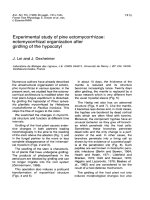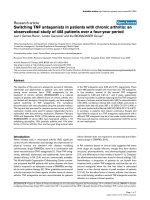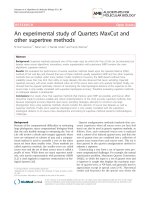Experimental study of turbulent currents over fixed 2d and 3d bottom roughness
Bạn đang xem bản rút gọn của tài liệu. Xem và tải ngay bản đầy đủ của tài liệu tại đây (1.69 MB, 226 trang )
EXPERIMENTAL STUDY OF TURBULENT CURRENT
OVER FIXED 2D AND 3D BOTTOM ROUGHNESS
ARLENDENOVEGA SATRIA NEGARA
NATIONAL UNIVERSITY OF SINGAPORE
2009
EXPERIMENTAL STUDY OF TURBULENT CURRENT
OVER FIXED 2D AND 3D BOTTOM ROUGHNESS
ARLENDENOVEGA SATRIA NEGARA
(B.Eng., Gadjah Mada University, Indonesia)
A THESIS SUBMITTED
FOR THE DEGREE OF MASTER OF ENGINEERING
DEPARTMENT OF CIVIL ENGINEERING
NATIONAL UNIVERSITY OF SINGAPORE
2009
ACKNOWLEDGMENTS
I would like to express my sincere gratitude to my thesis advisors, Professor
Cheong Hin Fatt and Professor Ole Secher Madsen, for their helpful suggestions,
valuable guidance, enthusiasm, and incredible patience during my research and
thesis work.
I am also grateful to the NUS Civil Engineering Department for giving me an
opportunity to study there and for providing me with the financial assistance. Thanks
are extended to Mr. Khrisna Sanmugam, Mr. Shaja Khan, Mr. Semawi Bin Sadi and
Mr. Roger Koh at the Hydraulic Laboratory for their assistance in preparing the
experimental setup and their valuable help throughout the experiment.
I am indebted to my parents who are constant though intangible towers of
encouragement and love. I would also like to thank all my Indonesian friends in
Singapore.
i
TABLE OF CONTENTS
Acknowledgement
i
Table of Contents
ii
Summary
v
List of Tables
vii
List of Figures
xi
List of Symbols
xix
Chapter 1
Introduction
1
1.1
Background
1
1.2
Objectives
3
1.3
Outline of the Thesis
4
Chapter 2
Bed Resistance in Uniform Flow
7
2.1
The Turbulent Boundary Layer
2.2
Current Boundary Layer
12
2.3
Wave Current Boundary Layer
15
Chapter 3
3.1
Experimental Setup And Methodology
7
24
Experimental Setup
24
3.1.1 Flume Experiments
24
3.1.2 Basin Experiments
27
ii
3.2
Instrumentation
31
3.2.1 Vectrino Velocimeter (Vectrino Acoustic Doppler
Velocimeter)
3.2.2 Nortek Acoustic Doppler Velocimeter (ADV)
Chapter 4
4.1.
Results and Discussion
31
33
34
Flume Experiments
35
4.1.1 Flow over smooth bed (Run FS)
36
4.1.2 Flow over gravel bed (Run FG)
41
4.1.3 Flow in direction perpendicular to triangular bars (Run F⊥)
45
4.1.4 Flow over triangular bars aligned perpendicular to the flow
with gravel placed between the bars. (Run FG⊥)
4.1.5 Flow in direction parallel to triangular bars (Run F//)
52
59
4.1.6 Flow over triangular bars aligned parallel to the flow with
gravel placed between the bars (Run FG//)
4.2
66
Basin Experiments
72
4.2.1 Flow over flat concrete bed (Run BS)
72
4.2.2 Flow over roughness bars at 30° angle to the flow with wave
guide plates (Run B30GP)
4.2.2.1
Velocity profiles and roughness in direction of channel
4.2.2.2. Turning of velocity vector along the channel
75
75
84
4.2.2.3. Velocity profiles and roughness resolved in direction
perpendicular to the ripple axis.
87
iii
4.2.2.4. Velocity profiles and roughness resolved in direction
parallel of the ripple axis.
93
4.2.3 Flow over triangular bars placed at angles of 30° to the
incident flow without guide plates (Run B30)
4.2.3.1
97
Velocity profiles and roughness in the direction of
channel
98
4.2.3.2. Turning of velocity vector along the channel (without
guide plates)
105
4.2.3.3. Velocity profiles and roughness resolved in the
direction perpendicular to the ripple axis (without
guide plates)
107
4.2.3.4. Velocity profiles and roughness resolved in the
direction parallel to the ripple axis (without guide
111
plates)
4.3
Summary of the Experimental Results
Chapter 5
Conclusions and Recommendations
116
118
5.1
Conclusions
118
5.2
Recommendations
124
References
126
Appendices
128
iv
SUMMARY
The shallow coastal zone along the inner continental shelf is an extremely
dynamic region where the fluid motions are associated with both surface waves and
currents. The effects of these motions extend down to the sea floor and interact with
bottom sediments with consequent formation of bed forms. Regular waves over fine
sediment beds are known to generate two-dimensional sharp crested ripples whose
crests are aligned parallel to the crests of the waves. In this study the ripples are
represented by artificial roughness element, which is triangular bars with a 90° edge
and vertex height of 1.5 cm. The overall objective of this study is to investigate the
bed roughness and shear velocity of the current flow over fixed artificial beds as a
preliminary step to obtain the base-line data necessary before going to the cases of
combined wave-current flows when the waves and currents are not co-directional.
The flume experiments consisted of a steady current flow over (a) smooth
glass bed, (b) a bed with gravel having diameters ranging from 3 mm to 6 mm, (c) a
bed with triangular bars aligned perpendicular to the flow at regular crest to crest
spacing of 10 cm, (d) a bed with triangular bars aligned perpendicular to the flow at
regular crest to crest spacing of 10 cm with gravel placed between them, (e) a bed
with triangular bars aligned parallel to the flow at regular crest to crest spacing of 10
cm and (f) a bed with triangular bars aligned parallel to the flow at regular crest to
crest spacing of 10 cm with gravel placed between them. The basin experiments
consisted of (a) preliminary experiments for flow over flat concrete bed in the
presence of guide plates, (b) flow over artificial roughness consisting of triangular
bars aligned at angle of 300 to the incident flow with the guide plates place and (c)
v
flow over triangular bars aligned at angle of 300 to the incident flow without guide
plates.
A number of experiments and numerical models on estimating the bed roughness
(e.g. Drake et.al [1992], Barrantes and Madsen [2000], Andersen and Faraci [2003],
and Faraci et.al. [2008]) showed some evidences of directional dependence of the
bed roughness. However, experimental results by Kularatne [2001] and field
measurements by Styles and Glenn [2002] show that there is no directional
dependence on the bed roughness for combined wave and currents. Resolving these
apparent contradicting results provided the motivation for this study.
The results for the basin experiments show that the velocity vector turns from
near-parallel to the ripples to the main flow direction as the distance above the
bottom increases. Resolving the near-bottom velocity vectors into components
normal and parallel to the ripples, the resulting velocity profiles are analyzed using
the log-profile method. The roughness determined from the normal velocity is in
agreement with results obtained in a glass flume in the Hydraulic Laboratory for
flow normal to the same bottom roughness configuration as well as with the findings
of Mathisen & Madsen (1996) and Barrantes & Madsen (2000). Thus, the conclusion
of the present study is that bottom roughness is directional dependent for currents
over 2D bottom roughness features. The results further provide a recommendation
for the region within the wave basin where reasonable uniformity in terms of bed
roughness, shear velocity and flow direction is expected, which is within the area of
0.75 < y ≤ 1.25 m and 3 ≤ x ≤ 5 m.
vi
LIST OF TABLES
Table 4.1
Comparison of Measured and Calculated Bed Roughness
(z0c) Estimates for Flow over the Smooth Glass Bed
Table 4.2
95% Confidence Intervals for Shear Velocity (u*c) for Flow
Over Smooth Glass Bed
Table 4.3
50
95% Confidence Intervals of Shear Velocity for Flow Over
Triangular Bars Aligned Perpendicular To The Flow
Table 4.7
45
Bed Roughness (z0c) and Shear Velocity (u*c) for Flow
over Triangular Bars Aligned Perpendicular to the Flow
Table 4.6
44
95% Confidence Intervals for Shear Velocity (u*c) for Flow
Over Gravel Bed.
Table 4.5
40
Bed Roughness (z0c) and Shear Velocity (u*c) for Flow
over Gravel Bed
Table 4.4
39
51
Bed Roughness (z0c) and Shear Velocity (u*c) for Flow
over Triangular Bars aligned Perpendicular to the Flow
with Gravel between the Bars
Table 4.8
Comparison of Roughness (kn) with other Experimental
Results
Table 4.9
56
57
95% Confidence Intervals of Shear Velocity for Flow over
Triangular Bars Aligned Perpendicular to the Flow with
Gravel Between The Bars
58
vii
Table 4.10
Bed Roughness (z0c) and Shear Velocity (u*c) for flow over
triangular bars aligned parallel to the flow
Table 4.11
95% Confidence Intervals for Shear Velocity (u*c) for Flow
over Triangular Bars Aligned Parallel to the Flow
Table 4.12
63
64
Bed Roughness (z0c) and Shear Velocity (u*c) for Flow
over Triangular Bars Aligned Parallel to the Flow for z ≤ 2
cm.
Table 4.13
66
Bed Roughness (z0c) and Shear Velocity (u*c) of Flow over
Triangular Bars Aligned Parallel to the Flow with Gravel
Placed between the Bars
Table 4.14
70
95% Confidence Intervals of Shear Velocity (u*c) for Flow
over Triangular Bars Aligned Parallel to the Flow With
Gravel Placed between the Bars
Table 4.15
The Exact Coordinate of the Measurement Points in Figure
4.25(a)
Table 4.16
80
95% Confidence Intervals for Shear Velocity (u*c) for Flow
in direction 30° to the Triangular Bars (with Guide Plates)
Table 4.18
77
Bed Roughness (z0c) and Shear Velocity (u*c) for Flow in
direction 30° to the Triangular Bars (with Guide Plates)
Table 4.17
71
83
The Turning Angles (α) for Flow over Triangular Bars
placed 30° to the Incident Flow at Elevation of z = 3 cm
86
viii
Table 4.19
Bed Roughness (z0c⊥) and Shear Velocity (u*c⊥) for
Resolved Velocity Profiles Perpendicular to the Ripple
Crest Line for Flow in direction 30° to the Triangular Bars
(with guide plates)
Table 4.20
90
The Average z0c⊥ for the Basin Experiments (with Guide
Plates) Compare with the Average z0c⊥ from Other
Experiments
Table 4.21
92
Bed Roughness (z0c//) and Shear Velocity (u*c//) for
Resolved Velocity Profiles Perpendicular to the Ripple
Crest Line for Flow in direction 30° to the Triangular Bars
(with guide plates)
Table 4.22
96
The Average z0c// for the Basin Experiments (with Guide
Plates) Compare with the Average z0c// from Other
Experiments
Table 4.23
The Exact Coordinate of the Measurement Points in Figure
4.34 (a)
Table 4.24
103
95% Confidence Intervals of Shear Velocity For Flow in
direction 30° to the Triangular Bars (without Guide Plates)
Table 4.26
100
Bed Roughness (z0c) and Shear Velocity (u*c) for Flow in
direction 30° to the Triangular Bars (without Guide Plates)
Table 4.25
97
104
The Turning Angles (α) for Flow over Triangular Bars
Placed 30° to the Incident Flow at Elevation of z = 3 cm
(without Guide Plates)
106
ix
Table 4.27
Bed Roughness (z0c⊥) and Shear Velocity (u*c⊥)
for
Resolved Velocity Profiles Perpendicular to the Ripple
Crest Line for Flow in direction 30° to the Triangular Bars
110
(without guide plates)
Table 4.28
The Average z0c⊥ for the Basin Experiments (without
Guide Plates) Compare with the Average z0c⊥ from Other
111
Experiments
Table 4.29
Bed Roughness (z0c )װand Shear Velocity (u*c)װ
for
Resolved Velocity Profiles Parallel to the Ripple Axis
(without guide plates)
Table 4.30
115
The Average z0c// for the Basin Experiments (without
Guide Plates) Compare with the Average z0c// from Other
Table 4.31
Experiments
116
Summary of the Experimental Results
117
x
LIST OF FIGURES
Figure 2.1
Skecth of boundary layer on a flat plate in parallel flow at
zero incidence (Schlichting, 1979)
8
Figure 2.2
Sketch of turbulent boundary layer mean velocity profile
9
Figure 2.3
Conceptualization of mixing and momentum transfer
(shear stresses) in turbulent boundary layer (Madsen, 1993)
10
Figure 3.1
Experimental layout in the flume
Figure 3.2
a) Smooth bed. [Run FS] b) Gravel bed (3-6mm diameter)
25
[Run FG]. c) Triangular bars aligned perpendicular to the
flow [Run F⊥]. d) Triangular bars aligned perpendicular to
the flow with gravel in between Run [FG⊥]. e) Triangular
bars aligned parallel to the flow [Run F//]. f) Triangular
bars aligned parallel to the flow with gravel in between
26
[Run FG//]
Figure 3.3
Sketch of
the current channel for (a) wave-current
interaction at angles of 60° over artificial roughness bars
(b) current alone over artificial roughness bars at angle of
30° to the incident flow
28
Figure 3.4
Basin layout for flow over smooth concrete bed
28
Figure 3.5
Basin layout for flow over artificial roughness bars at angle
of 30° to the incident flow with guide plates
29
xi
Figure 3.6
Basin layout for flow over artificial roughness bars at angle
of 30° to the incident flow without guide plates
29
Figure 3.7
Basin setup for flow over flat concrete bed [Run BS]
30
Figure 3.8
Basin setup for flow over artificial roughness bars at angle
of 30° to the incident flow with guide plates [Run B30GP]
Figure 3.9
30
Wave basin setup for flow over artificial roughness bars at
angle of 30° to the incident flow without guide plates [Run
B30]
31
Figure 3.10
Vectrino Velocimeter
32
Figure 4.1
Axis system for flume experiments
34
Figure 4.2
Axis system for basin experiments
35
Figure 4.3
Measurement location for flow over smooth glass bed
36
Figure 4.4
Velocity profiles at the centerline of the flume at 6 m
downstream of the inlet for flow over smooth glass bed
Figure 4.5
37
Semi-logarithmic plot of the velocity profile at the
centerline of the flume at 6 m downstream of the inlet for
flow over smooth glass bed
38
Figure 4.6
Measurement location for flow over gravel bed
41
Figure 4.7
Velocity profile at the centerline of the flume at 6 m
downstream of the inlet for flow over gravel bed
Figure 4.8
42
Semi-logarithmic plot of the velocity profiles at the
centerline of the flume at 6 m downstream of the
honeycomb inlet for flow over gravel bed
43
xii
Figure 4.9
Measurement locations for flow in direction perpendicular
to the triangular bars
Figure 4.10
46
Velocity profiles at crest and trough locations along the
centerline of the flume at 6m downstream of the
honeycomb outlet for flow over triangular bars aligned
perpendicular to the incident flow (x = 6m [crest]; x =
6.05m [trough]; x = 6.10m [crest]; 6.15m [trough])
Figure 4.11
47
Semi-logarithmic plot of the velocity profiles at crest and
trough locations along the center line of the flume at the
general location of 6m downstream of the honeycomb
outlet for flow over triangular bars aligned perpendicular to
the flow (x = 6m [crest]; x = 6.05m [trough]; x = 6.10m
[crest]; 6.15m [trough])
Figure 4.12
48
Measurement location for flow over triangular bars aligned
perpendicular to the flow with gravel placed between the
bars
Figure 4.13
52
Velocity profiles at crest and trough locations along the
centerline of the flume at 6m downstream of the
honeycomb outlet for flow over triangular bars aligned
perpendicular to the incident flow with gravel placed
between the bars. (x = 6m [crest]; x = 6.05m [trough]; x =
6.10m [crest]; 6.15m [trough])
53
xiii
Figure 4.14
Semi-logarithmic plot of the velocity profiles at crest and
trough locations along the center line of the flume at the
general location of 6m downstream of the honeycomb
outlet for flow over triangular bars aligned perpendicular to
the flow with gravel between the bars. (x = 6m [crest]; x =
6.05m [trough]; x = 6.10m [crest]; 6.15m [trough])
Figure 4.15
Measurement location for flow in direction parallel to
triangular bars
Figure 4.16
54
59
Velocity profiles at x = 5m downstream of the honeycomb
outlet for flow over triangular bars aligned parallel to the
flume axis (y=20cm [crest]; y=25cm [trough]; y=30cm
[crest at centerline]; y=35cm [trough]; y=40cm [crest]
Figure 4.17
60
Semi-logarithmic plot of the velocity profiles at 5m
downstream of the honeycomb outlet for flow over
triangular bars with 10 cm spacing aligned parallel to the
flow (y = 20 cm [crest]; y = 25 cm [trough]; y = 30 cm
[crest]; y=35 cm [trough]; y=40 cm [crest])
Figure 4.18
62
Semi-logarithmic plot of the velocity profiles above the
trough at 5m downstream of the honeycomb outlet for flow
over triangular bars with 10 cm spacing aligned parallel to
the flow at elevation of z ≤ 2cm
Figure 4.19
65
Measurement location for flow over triangular bars aligned
parallel to the flow with gravel placed between the bars
66
xiv
Figure 4.20
Velocity profiles at x=5m downstream of the honeycomb
outlet for flow over triangular bars aligned parallel to the
flow with gravel placed between the bars (y=20cm [crest];
y=25cm [trough]; y=30cm [crest at centerline]; y=35cm
[trough]; y=40cm [crest])
Figure 4.21
67
Semi-logarithmic plot of the velocity profiles at x=5m for
flow over triangular bars aligned parallel to the flow with
gravel placed between the bars (y=20cm [crest]; y=25cm
[trough]; y=30cm [crest at centerline]; y=35cm [trough];
y=40cm [crest])
Figure 4.22
69
Locations of the velocity profile measurement for flow
over flat concrete bed
Figure 4.23
73
Depth averaged velocities across the current channel at
sections 3m, 3.5m and 4.5m downstream the honeycomb.
Figure 4.24
The variation of α in the current channel for flow over a
74
concrete bed
Figure 4.25
(a) Locations of the velocity profile measurement
(b)
Location of the crest and trough (with guide plates)
Figure 4.26
74
76
Velocity profile (u) for crest and trough positions nearest
to centerline of the current channel 5 m downstream of the
honeycomb outlet for flow over triangular bars placed at
angles of 30° to the flow (with guide plates)
78
xv
Figure 4.27
Semi-logarithmic plot of the velocity profile (u) for crest
and trough positions nearest to centerline of the current
channel at 5 m downstream of the honeycomb outlet for
flow over triangular bars placed at angles of 30° to the
incident flow (with guide plates)
Figure 4.28
79
The turning angles (α) at the centerline of the current
channel at (a) x = 3m, (b) x = 4m and (c) x = 5m
downstream of the honeycomb outlet (with guide plates)
85
Figure 4.29
Sketch of the velocity components
87
Figure 4.30
Velocity profiles of u⊥ for crest and trough positions
nearest to centerline location 5m downstream of the
honeycomb outlet (with guide plates)
Figure 4.31
88
Semi-logarithmic plot of velocity profiles of u⊥ for crest
and trough positions nearest to centerline location 5m
downstream of the honeycomb outlet (with guide plates)
Figure 4.32
89
Velocity profiles of u// for crest and trough positions
nearest to centerline location 5m downstream of the
honeycomb outlet (with guide plates)
Figure 4.33
93
Semi logarithmic plot of the velocity profiles of u// for
crest and trough positions nearest to centerline location 5
m downstream the honeycomb outlet (with guide plates)
94
xvi
Figure 4.34
(a) Locations of velocity measurement for flow over
roughness bars placed at angles of 30° to the incident flow
(b) Location of crest and trough (without guide plates)
Figure 4.35
99
Velocity profiles (u) for crest and trough positions nearest
to centerline of the current channel 5 m downstream of the
honeycomb outlet for flow over triangular bars placed at
angles of 30° to the flow (without guide plates)
Figure 4.36
100
Semi-logarithmic plot of the velocity profiles (u) for crest
and trough positions nearest to centerline of the current
channel 5 m downstream of the honeycomb outlet for flow
over triangular bars placed at angles of 30° to the flow
(without guide plates)
Figure 4.37
102
The turning angles (α) at the centerline of the current
channel at (a) x = 4 m, and (b) x = 5 m downstream the
honeycomb inlet (without guide plates)
Figure 4.38
105
Velocity profiles of u⊥ for crest and trough positions
nearest to centerline at x = 5m downstream of the
honeycomb outlet (without guide plates)
Figure 4.39
107
Semi-logarithmic plot of velocity profiles of u⊥ for crest
and trough positions nearest to centerline at x = 5m
downstream of the honeycomb outlet (without guide
plates)
108
xvii
Figure 4.40
Velocity profiles of u// for crest and trough positions
nearest to centerline of the current channel at x = 5m
downstream of the honeycomb outlet (without guide
plates)
Figure 4.41
112
Semi-logarithmic plot of velocity profiles of u// for crest
and trough positions nearest to centerline of the current
channel at x = 5m downstream of the honeycomb outlet
(without guide plates)
113
xviii
LIST OF SYMBOLS
d
Gravel diameter
d’
Displacement height
kn
The equivalent NIkuradse Sand Grain Roughness
l
Mixing length
pδ
The pressure at the outer edge of the boundary layer symbolically taken at z=δ
R
Regression coefficient
t
Time
u*c
Current shear velocity
u
Velocity component in x-direction (current direction)
u’
Turbulent velocity fluctuation in x direction
u∞
Free stream velocity
v
Velocity component in the y direction
v’
Turbulent velocity fluctuation in y direction
w
Velocity component in the z direction
w’
Turbulent velocity fluctuation in z direction
w+’ The rate of upward mass transfer per unit horizontal area
w_’ The rate of downward mass transfer per unit horizontal area
x
Coordinate parallel to bottom and positive in the direction of the current flow
y
Coordinate parallel to bottom and positive in the direction 90° counterclockwise from x-axis
z
Coordinate normal to bottom (positive upwards)
xix
z0c
Bottom roughness experienced by current
Greek Symbols
α
Angle between current direction (x direction) and the resultant velocity of u
and v
δ
Boundary Layer Thickness
η
Ripple height
κ
Von Karman’s constant
λ
Ripple length
ν
Molecular viscosity
νt
turbulent viscosity
θ
Angle between ripple crest line and the current direction
ρ
Fluid density
τ
Shear stress
Subscript
( )c Quantity associated with current
xx
CHAPTER 1
INTRODUCTION
1.1. Background
Waves in the presence of a current have significant influences on the transport
of sediment in the coastal zone even before the waves break near the shore. Waves
are known to entrain the sediment from the seabed for the currents to carry over large
distances. Before the breaker zone, waves shoal and refract towards the shore in
response to the changing water depth. In the coastal environment, it has been
observed that waves propagate towards the shore with angles of attack less than 450.
Further, tidal and longshore currents run parallel to the shore and we have wave
current interactions with angles of attack varying from 00 (orthogonal) to around 450.
Therefore, one can expect that waves and currents interact at various angles and there
is limited information in the literature for such interaction angles.
Below the waves, there exists a very thin layer adjacent to the bottom where
high velocity gradients are present. This wave bottom boundary layer has limited
time to grow because of the oscillatory nature of wave orbital velocity. Large bottom
shear stresses and high levels of turbulence intensities can be expected within the
wave boundary layer due to the high shear stresses existing within the very thin
boundary layer.
Under an oscillatory wave travelling over a sediment bed, there is a complex
interaction between the wave motions and the sediment, which leads to the formation
of small sediment bed features called ripples. The ripples in turn affect the flow by
1
inducing form drag due to the effect of flow separation over the ripples. Regular
waves over fine sediment beds are known to generate two-dimensional sharp crested
ripples whose crests are aligned parallel to the crests of the waves.
However, a tidal current that varies over a much longer period of the order
many hours has somewhat different characteristics. The longer timescales of a slowly
varying current typically leads to a relatively thick bottom boundary layer
(Mathiesen and Madsen, 1996). Currents are also capable of generating bed forms
but the higher shear stresses existing in the wave boundary layers dictate that waves
are the primary agent for the entrainment of the sediments and currents are
responsible for the transport of the entrained sediments. These are movable bed
forms arising from wave current interactions.
Under a controlled environment with artificial roughness elements in a
laboratory flume, Mathisen & Madsen (1996a,1996b) showed experimentally that a
single roughness can be used to characterize the passage of pure currents, pure waves
and combined waves and currents over the two dimensional roughness elements. In
all these experiments, the two dimensional roughness elements were aligned
perpendicular to the flow.
Barrantes and Madsen (2000) also conducted experiments involving a steady
current (no wave) in the laboratory flume where the rippled bottom is simulated by
roughness elements aligned at various angles (00, 300, 450 and 600) to the flow. They
concluded that “waves and currents over a rippled bed bottom will not experience the
same equivalent bottom roughness when the current is at an angle to the direction of
wave propagation” and that “the singled valued bottom roughness for combined
wave-current flows over a rippled bottom demonstrated by Mathisen & Madsen
2
(1996b) is limited to the special case of co-directional waves and currents”. It is
noted that the experiments described by Mathisen & Madsen (1996a, 1996b) and
Barrantes & Madsen (2000) were conducted in the same flume with a length of 28 m,
a width of 0.76 m and a depth of 0.9 m.
The conclusions of Barrantes & Madsen (2000) on the “direction dependent
bottom roughness” based on experiments in a flume with a flow having a width to
depth ratio of 1.27 have provided the primary motivation for this study. This study
would be primarily for current flow and also account for the effect of the flume width
by conducting experiments involving various roughness elements in (a) a flume of
length 12m, width 0.6m with a water depth of 0.4m (width to depth ratio of 1.5) as
well as (b) in a wave basin with a wider current stream of 2m over a length of 6m in
a water depth of 0.4m (approximate width to depth ratio of 5).
1.2. Objectives
The overall objective of this study is to investigate the bed roughness and shear
velocity of the current flow over fixed artificial beds as a preliminary step to obtain
the base-line data necessary before going to the cases of combined wave-current
flows when the waves and currents are not co-directional. The experiments were
performed in the Hydraulics Laboratory, Civil Engineering Department, National
University of Singapore, using a 33 m x 10 m x 0.9 m wave basin and a 12 m x 0.6 m
x 0.6 m glass flume. From the results of this experimental study, the roughness factor
for different directional interaction of currents with artificial roughness are
summarized and compared with earlier results of Mathisen & Madsen (1996a)
Barrantes and Madsen (2000).
3
